Are you a proud cat owner or thinking of adopting one soon? If so, it’s crucial to understand how to take care of your feline friend’s ears properly. Dirty cat ears and ear mites are two common ear problems that can cause discomfort and even severe health issues if left untreated.
It can be challenging to differentiate between the two if you don’t know what to look for. But don’t worry, in this post, we’ll help you learn how to tell the difference and provide you with useful tips on how to care for your cat’s ears effectively.
Dirty cat ears are a natural occurrence caused by the buildup of earwax. However, ear mites are parasitic infections that can wreak havoc on your cat’s ear canal. So, it’s essential to spot the symptoms early on and seek proper treatment.
In this article, we’ll give you an overview of the differences between dirty cat ears and ear mites. We’ll also discuss their symptoms, causes, and prevention methods. By the end of this post, you’ll be equipped with all the knowledge necessary to keep your furry companion’s ears healthy and happy.
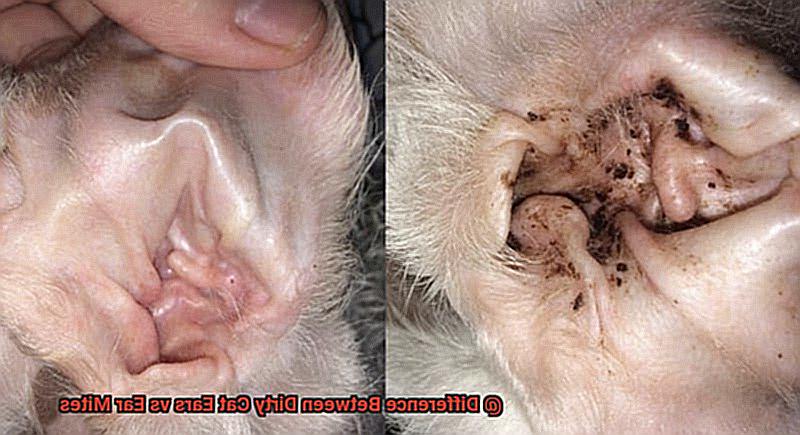
What are Ear Mites and How Do Cats Get Them?
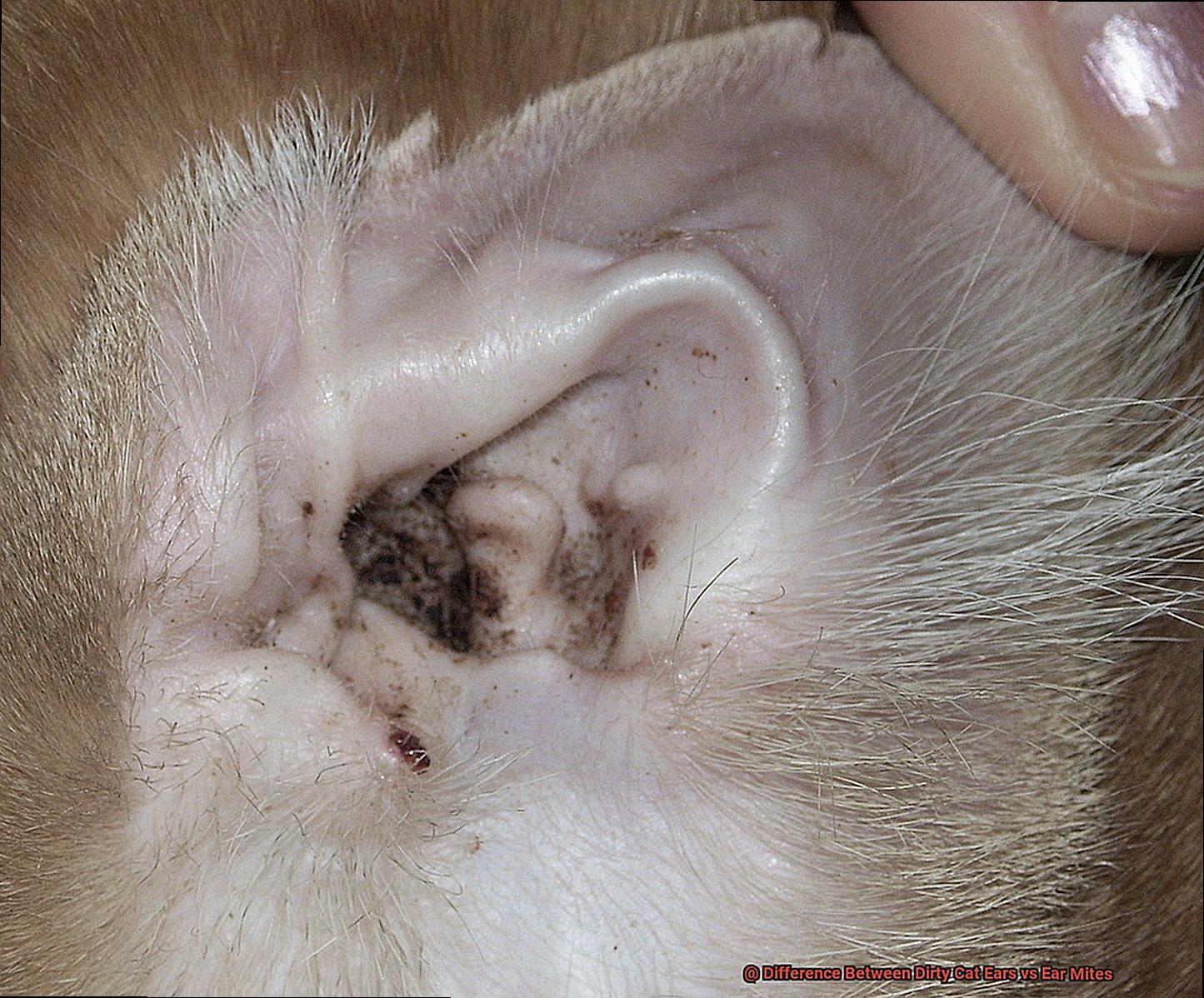
Ear mites are the tiny, pesky parasites that can cause discomfort and even infections in cats. These microscopic creatures live in the ear canal and feed on the wax and oils of a cat’s ear, leading to irritation and inflammation. But how do cats get ear mites, and how can you tell if your feline friend has them?
If your cat spends time outdoors or lives with other cats, they are more likely to get ear mites. Kittens and older cats with weakened immune systems are also at higher risk of developing ear mite infestations. These parasites are highly contagious, easily spreading from one animal to another through direct contact or shared bedding, grooming tools, or toys.
So, how can you tell if your cat has ear mites? One way is to examine the discharge present in their ears. If the discharge is brown, waxy, and has a slightly musty odor, it is likely just normal ear wax and debris buildup. However, if the discharge is dark brown or black and looks like coffee grounds, it could indicate the presence of ear mites. Another way to tell is by observing your cat’s behavior – cats with ear mites may shake their heads frequently or scratch at their ears excessively.
If you suspect your cat may have ear mites, it is essential to take them to a veterinarian for proper diagnosis and treatment. The vet will use an otoscope to examine your cat’s ears and may take a sample of the ear wax for microscopic analysis. Treatment for ear mites usually involves cleaning the ears with a special solution to remove debris and applying medication to kill the mites. In severe cases, oral medication or injections may be necessary.
It is crucial to note that not all dirty cat ears are caused by ear mites. Other factors such as allergies, bacterial or yeast infections, foreign objects, or excessive wax buildup can also cause dirty ears in cats. Therefore, if you notice any unusual behavior or discharge in your cat’s ears, it is best to consult with your veterinarian for proper diagnosis and treatment.
Ear mites can be a nuisance for cats, but with proper diagnosis and treatment, they can be easily managed. By keeping an eye on your cat’s behavior and taking them to the vet for regular check-ups, you can keep their ears clean and healthy.
Examining Discharge to Differentiate between Dirty Cat Ears and Ear Mites
One way to do this is by keeping their ears clean and free of any unwanted visitors like ear mites. But how can you tell the difference between dirty ears and an ear mite infestation? Examining the discharge in your cat’s ears is a critical step in differentiating between the two.
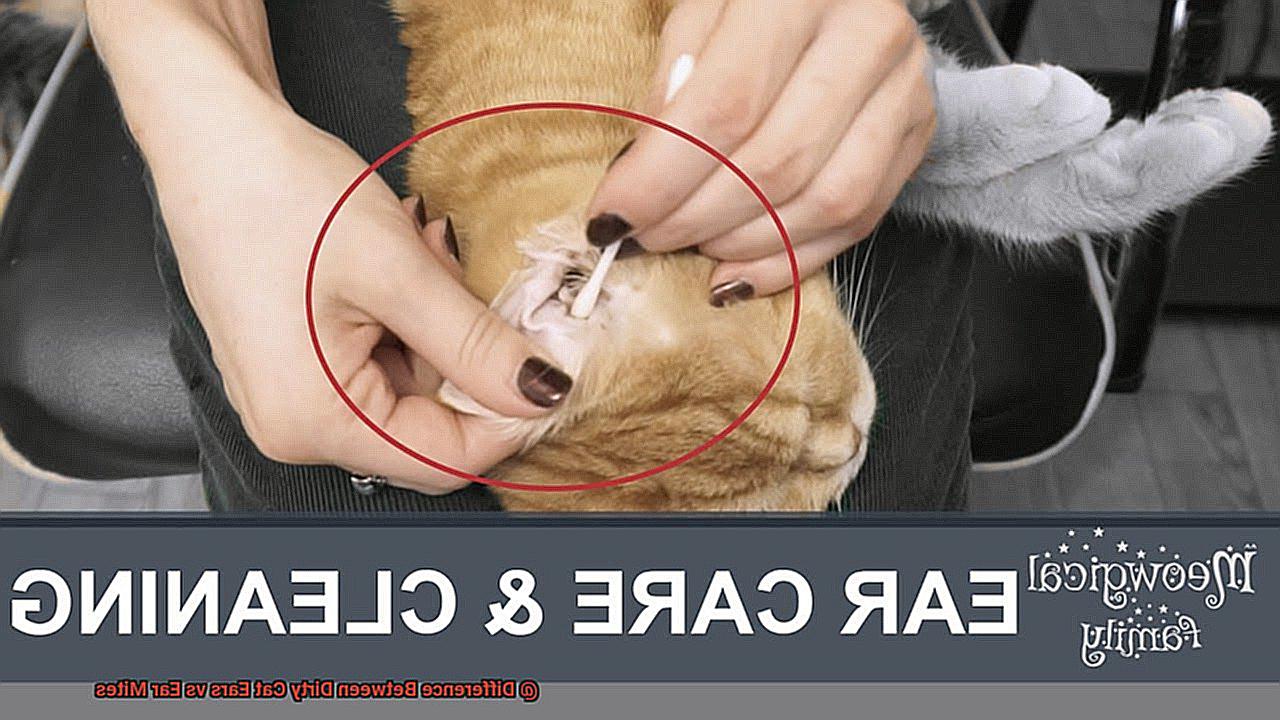
To start, it’s essential to know what you’re looking for. Dirty ears may have a buildup of wax and debris, while ear mites can cause a dark, coffee ground-like discharge in the ears. To examine the discharge, you should first clean your cat’s ears with an ear cleaning solution to remove any excess wax or debris, ensuring you don’t push any discharge further into the ear canal.
Once you’ve cleaned your cat’s ears, use a cotton ball or pad to wipe away any visible discharge.
If you notice a dark, coffee ground-like discharge, this could be a sign of ear mites. Ear mites can be irritating and cause inflammation in the ear canal, leading to excessive wax production and the dark discharge.
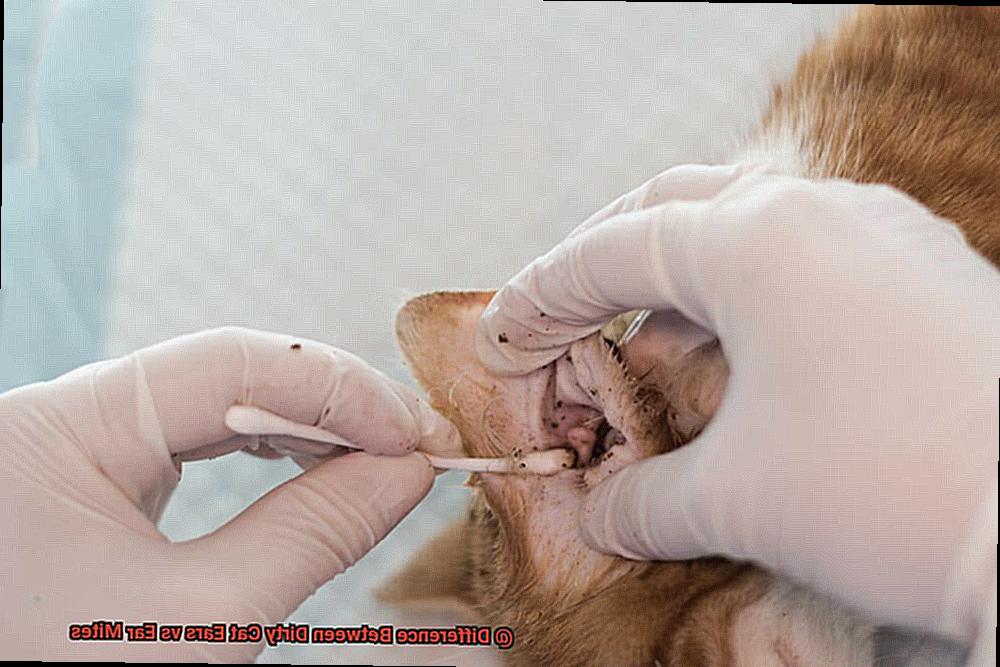
In addition to the discharge, your cat may frequently scratch their ears or shake their head.
However, if you only see a buildup of wax and debris without any dark discharge, your cat’s ears may just be dirty. It’s important to note that while dirty ears don’t always indicate ear mites, they should still be cleaned regularly to prevent infections and discomfort for your cat.
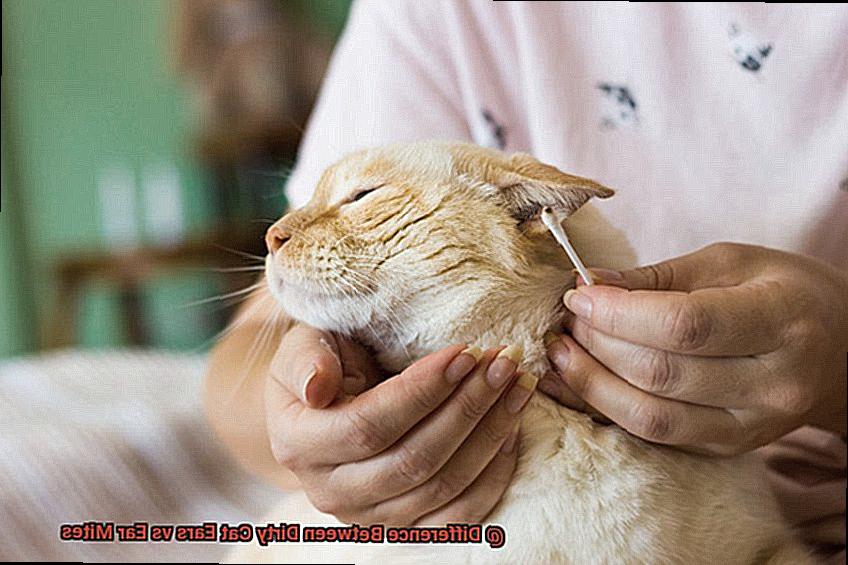
By taking care of your cat’s ears regularly through cleaning and maintenance, you can prevent both dirty ears and ear mites from occurring. Remember always to consult with your veterinarian for proper diagnosis and treatment options if necessary.
Observing Behavior to Distinguish between Dirty Cat Ears and Ear Mites
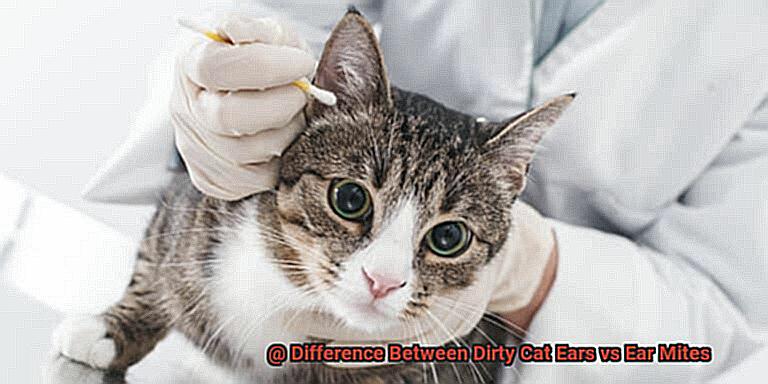
One crucial aspect of their health is observing their behavior to determine if they have dirty ears or ear mites. Dirty ears can be caused by a range of factors, such as excess wax or debris buildup, whereas ear mites are tiny parasites that take up residence in the ear canal.
One telling behavior to keep an eye out for is excessive scratching or shaking of the head. If your cat is constantly pawing at their ears or shaking their head, it could indicate the presence of ear mites. These pesky parasites cause irritation and inflammation in the ear canal, leading to discomfort for your beloved pet.
Another observation to make is whether your cat seems bothered by loud noises or sudden movements. This could be a sign that they are experiencing discomfort in their ears due to ear mites. However, it’s important to note that not all cats with dirty ears have ear mites, so it’s recommended to consult with a veterinarian to get an accurate diagnosis.
If you notice discharge or a foul odor emanating from your cat’s ears, it could be a sign of either dirty ears or ear mites. However, if the discharge is brown and waxy, it’s more likely a sign of dirty ears. On the other hand, if the discharge is dark and crusty, it could indicate an ear mite infestation.
By observing your cat’s behavior and any signs of discomfort or unusual discharge from their ears, you can tell the difference between dirty cat ears and ear mites. If you suspect that your cat has ear mites, it’s critical to seek veterinary care promptly to prevent any further complications.
Can Cats Have Dirty Ears Without Ear Mites?
One of the most common questions that arise is whether cats can have dirty ears without having ear mites. The answer is a resounding yes. Dirty ears in cats can result from various factors like wax buildup, dirt, and debris. Therefore, it’s crucial to differentiate between normal dirt and potential ear mite infestations.
Ear mites are tiny parasites that live in the ear canal of cats and can cause discomfort and irritation. If left untreated, they can lead to itching, inflammation, secondary infections or hearing loss. Thus, keeping your cat’s ears clean and free from debris is vital to prevent any issues from arising.
To maintain good ear hygiene for your furry friend, regular cleaning with a vet-approved ear cleaner and cotton balls should be done at home. It’s a straightforward task that can prevent any potential health issues from arising.
Additionally, if you notice any signs of discomfort or itching in your cat’s ears, it’s best to consult with a veterinarian to determine if there is an underlying issue that needs to be addressed.
Is Yeast Infection of the Ears the Same as Ear Mites?
When it comes to ear infections, it can be hard to know what you’re dealing with. That’s why we’re here to help answer the question: is yeast infection of the ears the same as ear mites?
The short answer is no. While these two conditions can have similar symptoms, they are caused by different things and require different treatments.
Yeast infection of the ears is caused by an overgrowth of yeast in the ear canal. This can happen due to allergies, hormonal imbalances or other underlying health issues. Symptoms of a yeast infection include a strong, unpleasant odor from the ears, redness and inflammation, and thick, brown or black discharge.
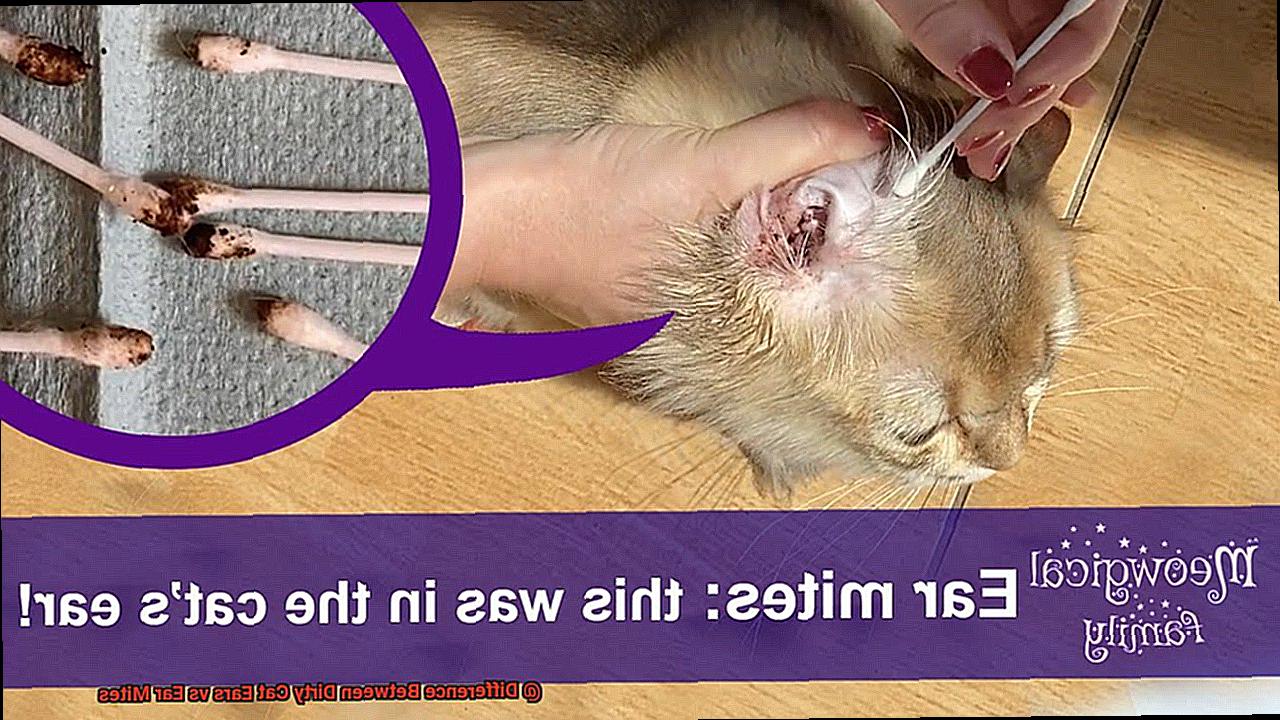
On the other hand, ear mites are tiny parasites that live in the ear canal and feed on ear wax and skin cells. They’re highly contagious and can be transmitted between cats through close contact or sharing bedding. Symptoms of ear mites include intense itching, shaking of the head, scratching at the ears, and a dark, crumbly discharge that resembles coffee grounds.
While both conditions can cause discomfort and irritation for your cat, they require different treatments. A veterinarian can diagnose whether your cat has a yeast infection or ear mites through a physical exam and lab tests if necessary. Treatment for a yeast infection typically involves cleaning the ear canal and using antifungal medication, while treatment for ear mites involves using topical or oral medication to kill the parasites.
It’s essential to seek veterinary care if you suspect your cat may have either condition. Proper diagnosis and treatment are crucial for your cat’s health and well-being.
What Do Normal Dirty Cat Ears Look Like?
Normal dirty cat ears should have a slight yellow or brownish wax buildup. But don’t fret, this is completely natural and part of your kitty’s ear cleaning process. It’s important to note that cats produce more wax than humans, so some wax buildup is to be expected.
However, if your cat’s ears appear excessively dirty or have a strong odor, it could be a sign of an underlying issue such as an infection or ear mites. To keep your feline friend healthy, it’s essential to monitor their ears regularly and seek veterinary attention if you notice any concerning changes.
It’s worth noting that some cats may have lighter colored wax that appears almost white. This is still considered normal as long as there are no other concerning symptoms. If you’re unsure whether your cat’s ears look normal or not, it’s always best to consult with your veterinarian for guidance.
In addition to regular check-ups, routine ear cleaning can help maintain healthy and normal looking ears in cats. Your veterinarian can recommend appropriate cleaning products and techniques for your cat’s specific needs.
What Do Cats’ Ears Look Like with Ear Mites?
One of the most common issues that can affect cats is ear mites. Ear mites are minuscule, crab-like parasites that reside in a cat’s ear canal and feed on the wax and oils produced by their skin. But what exactly do a cat’s ears look like with ear mites?
If your furry friend has ear mites, you may notice a dark, crumbly substance in their ear canal, which resembles coffee grounds. Additionally, they may excessively scratch or shake their head and tilt their head to one side. Their once pristine ears may also appear red and inflamed, and there may be an unpleasant odor emanating from the ears.
It is vital to note that while these symptoms are typical in cats with ear mites, they can also be indicative of other ear problems such as bacterial or yeast infections. Therefore, it is crucial to have a veterinarian examine your cat’s ears to determine the underlying cause of any symptoms.
Keeping your cat’s ears healthy is paramount for their overall wellbeing. Regular check-ups and cleaning can help prevent and identify any problems early on. If you suspect that your cat has ear mites or any other ear issues, do not hesitate to seek veterinary care.
Treatment for Ear Mite Infestations in Cats
So, when they’re uncomfortable and in pain because of pesky ear mites, it’s essential to take action. Luckily, there are several treatments available to help get rid of these parasites and relieve your cat’s discomfort.
Before administering any medication, it’s crucial to clean your cat’s ears thoroughly. Your veterinarian can recommend a gentle ear cleaner, and you can use a soft cloth or cotton ball to carefully clean the ears. Once the ears are clean, you can start treatment.
Topical treatments, such as ear drops, creams, and sprays, are applied directly into the ear canal. These medications contain insecticides or parasiticides that kill the mites and their eggs. Additionally, some topical treatments contain corticosteroids that help reduce inflammation and discomfort.
Oral medications are also effective in treating ear mite infestations in cats. These medications come in the form of tablets or liquids and work by killing the mites as they feed on your cat’s blood. It’s vital to follow the dosage instructions carefully and complete the full course of treatment, even if symptoms improve before the medication is finished.
Along with medication, keeping your cat’s environment clean is crucial to prevent re-infestations. You can wash bedding, vacuum carpets and furniture regularly and treat other pets in the household for ear mites if necessary.
Regular check-ups with a veterinarian can also help prevent and treat ear mite infestations in cats. During these check-ups, your veterinarian can perform a thorough ear exam and provide recommendations for preventing future infestations. By working closely with your veterinarian and following their recommendations, you can keep your feline friend comfortable and healthy.
Ear mite infestations in cats can be effectively treated with medication and proper cleaning techniques. Taking care of your cat’s ears is crucial for their overall health and wellbeing.
fxRiuicl2v4″ >
Conclusion
As a cat owner, understanding the difference between dirty cat ears and ear mites is crucial. While dirty ears are a natural occurrence caused by wax buildup, ear mites are parasitic infections that can lead to severe health issues if left untreated. But fear not. There are several ways to tell them apart.
Firstly, examining the discharge present in your cat’s ears can be helpful. If the discharge is brown, waxy, and has a slightly musty odor, it’s likely just normal earwax and debris buildup. However, if it’s dark brown or black and looks like coffee grounds, it could indicate the presence of ear mites. Secondly, observing your cat’s behavior can also give you clues – cats with ear mites may shake their heads frequently or scratch at their ears excessively.
If you suspect your cat may have ear mites or any other ear issues, don’t hesitate to consult with your veterinarian for proper diagnosis and treatment options. Treatment for ear mites usually involves cleaning the ears with a special solution to remove debris and applying medication to kill the pesky critters.
Regular cleaning and maintenance of your cat’s ears are essential to prevent both dirty ears and ear mites from occurring. By keeping an eye on your feline friend’s behavior and any signs of discomfort or unusual discharge from their ears, you can easily differentiate between dirty cat ears versus ear mites.
In conclusion, taking care of your furry companion’s ears requires regular check-ups with a veterinarian, routine cleaning at home, and prompt diagnosis and treatment when necessary.

